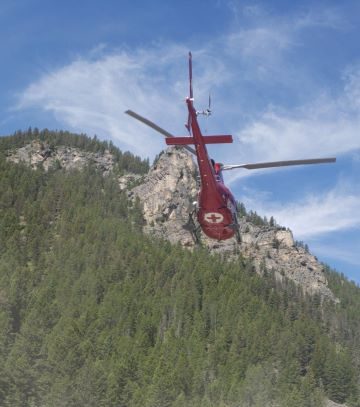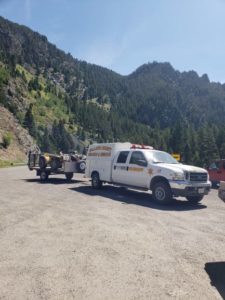Arts & Entertainment
Recreational safety 101
Published
6 years agoon
Posted By
Outlaw Partners
EBS STAFF
Hiking may seem like a relatively safe outdoor activity compared to more extreme sports like downhill mountain biking or whitewater kayaking, but unexpected situations can occur, whether an injury or simply getting lost.
Since the beginning of this year, Gallatin County Search and Rescue, a division of Gallatin County Sheriff’s Office, has conducted 38 rescues and 22 searches county-wide. Of those, eight rescues and 11 searches were in Gallatin Canyon and the Big Sky area.
In regards to hiking incidents specifically, there were reports of heart problems, a broken ankle, dislocated hip, and a person separated from their group.
“Nature is a funny thing,” wrote Gallatin County Sheriff Brian Gootkin in a press release about two back-to-back rescue situations in the canyon. “Even the most prepared and expert hikers can’t predict getting startled by a fox, twisting wrong and blowing out a hip. That is an injury that you need help to get out with. Get out, be healthy and responsibly enjoy great mountain living. When you do make sure you have the gear and communication that allows us to help you when nature does her thing. Enjoy the back country with other people when possible, stay together when hiking and carry a means of communication with you.”
Gallatin County Search and Rescue Captain Jason Jarett said that most of the rescue missions—whether ATV crashes, climbing accidents, hiking or mountain biking—are gravity-related, or what he calls “slip, trip or fall” situations.
He said that most of the calls come from locals because locals spend the most time in surrounding wilderness areas.
“Our backyard is backcountry,” Jarrett said. “So when you trip and blow your ankle out, or fall and blow your knee out, where most people can hobble back to their car, here you find yourself at 10,000 feet and [deep in the wilderness].”
Taking into account the time it might take you to reach help, or for help to reach you, Jarrett advises to carry enough gear to survive the elements longer than you plan to be out there.
Here are a few more precautions you can take to reduce the risk of injury or a situation becoming dire, and how to be prepared should you find yourself in a less than ideal situation.


In late July, Gallatin County Search and Rescue personnel, Gallatin Gateway Fire Department, and Reach Air Medical Services, conducted a successful rescue operation to retrieve a 37-year-old woman who fell and lost consciousness while hiking at Gallatin Tower. PHOTOS BY LEO MCATEE
Bring a topographical map or guide book. Know the terrain, elevation changes, and any crossroads you will encounter. Carry a current trail map and know how to read it.
Hike with a friend. The old adage “safety in numbers” applies to hiking too. Hiking in groups is an easy and fun way to protect against hiking dangers. Be sure to have at least one companion, but when hiking into remote areas, it’s advisable to have a minimum of four people in your group. If someone gets hurt, that leaves one person to stay with the injured party, while two others can go get help.
Tell someone where you are going and when you are returning. Leave a copy of your itinerary with a friend or family member and when you plan to return. Include details like the make, year, and license plate of your car; and emergency contact information.
Wear properly fitting shoes with good ankle support. Slick logs, river stones, trail rocks and exposed roots have been known to cause fractured ankles. Don’t try to break in brand new shoes on a long hike. Take along an extra pair of synthetic socks to prevent blisters.
Use a walking stick. Walking sticks and hiking poles provide added support and leverage, and an advance sense of the terrain ahead. Some people hike with one; some people hike with two—figure out what feels right for you.
Take along a good compass. Know how to read it and always know which direction you should be heading.
Bring appropriate clothing. Dress for trail and weather conditions. In rapidly changing weather conditions, bring lightweight layers.
Be aware of wildlife. Be aware of possible encounters with wild animals and treat any encounters with extreme caution.
Emergency signaling devices. Pack an emergency signaling device like a flashlight or small mirror and know the location of the nearest ranger station or park office to send distress signals in the case of an emergency.
Take plenty of drinking water. A minimum of two quarts per person per day is suggested. Don’t drink stream, river, or lake water—it may look clean and refreshing, but mountain stream water can make you ill.
Stay on trails. Walking off-trail does not only cause erosion, but it also increases the likelihood of getting injured or lost.
Watch your step. Pay attention your footing when near cliffy areas. Stay on developed trails or dry, solid rock areas with good footing.
The Outlaw Partners is a creative marketing, media and events company based in Big Sky, Montana.


Upcoming Events
november, 2024
Event Type :
All
All
Arts
Education
Music
Other
Sports
Event Details
Spanish Classes with World Language InitiativeThese unique, no cost Spanish classes are made possible by the contribution of Yellowstone Club
more
Event Details
Spanish Classes with World Language InitiativeThese unique, no cost Spanish classes are made possible by the contribution of Yellowstone Club Community Foundation (YCCF) and Moonlight Community Foundation (MCF). This class will focus on building a lifelong affinity for world languages and cultures through dynamic and immersive Communicative Language teaching models.
Beginner Class – Mondays and Wednesdays from 5:30-6:30 pm
Intermediate Class – Mondays and Wednesdays from 6:45- 7:45 pm
- Classes begin Oct.7, 2024 and run for 6 weeks
- Class size is limited to 12 students
- Classes are held in Big Sky at the Big Sky Medical Center in the Community Room
For more information or to register follow the link below or at info@wlimt.org.
Time
October 28 (Monday) 5:30 pm - December 4 (Wednesday) 7:45 pm
Location
Big Sky Medical Center - Community Room (2nd Floor)
Big Sky Medical Center - Community Room (2nd Floor)
Event Details
Spanish Classes with World Language InitiativeThese unique, no cost Spanish classes are made possible by the contribution of Yellowstone Club
more
Event Details
Spanish Classes with World Language InitiativeThese unique, no cost Spanish classes are made possible by the contribution of Yellowstone Club Community Foundation (YCCF) and Moonlight Community Foundation (MCF). This class will focus on building a lifelong affinity for world languages and cultures through dynamic and immersive Communicative Language teaching models.
Beginner Class – Mondays and Wednesdays from 5:30-6:30 pm
Intermediate Class – Mondays and Wednesdays from 6:45- 7:45 pm
- Classes begin Oct.7, 2024 and run for 6 weeks
- Class size is limited to 12 students
- Classes are held in Big Sky at the Big Sky Medical Center in the Community Room
For more information or to register follow the link below or at info@wlimt.org.
Time
November 4 (Monday) 5:30 pm - December 11 (Wednesday) 7:45 pm
Location
Big Sky Medical Center - Community Room (2nd Floor)
Big Sky Medical Center - Community Room (2nd Floor)
Event Details
Spanish Classes with World Language InitiativeThese unique, no cost Spanish classes are made possible by the contribution of Yellowstone Club
more
Event Details
Spanish Classes with World Language InitiativeThese unique, no cost Spanish classes are made possible by the contribution of Yellowstone Club Community Foundation (YCCF) and Moonlight Community Foundation (MCF). This class will focus on building a lifelong affinity for world languages and cultures through dynamic and immersive Communicative Language teaching models.
Beginner Class – Mondays and Wednesdays from 5:30-6:30 pm
Intermediate Class – Mondays and Wednesdays from 6:45- 7:45 pm
- Classes begin Oct.7, 2024 and run for 6 weeks
- Class size is limited to 12 students
- Classes are held in Big Sky at the Big Sky Medical Center in the Community Room
For more information or to register follow the link below or at info@wlimt.org.
Time
November 11 (Monday) 5:30 pm - December 18 (Wednesday) 7:45 pm
Location
Big Sky Medical Center - Community Room (2nd Floor)
Big Sky Medical Center - Community Room (2nd Floor)
Event Details
Spanish Classes with World Language InitiativeThese unique, no cost Spanish classes are made possible by the contribution of Yellowstone Club
more
Event Details
Spanish Classes with World Language InitiativeThese unique, no cost Spanish classes are made possible by the contribution of Yellowstone Club Community Foundation (YCCF) and Moonlight Community Foundation (MCF). This class will focus on building a lifelong affinity for world languages and cultures through dynamic and immersive Communicative Language teaching models.
Beginner Class – Mondays and Wednesdays from 5:30-6:30 pm
Intermediate Class – Mondays and Wednesdays from 6:45- 7:45 pm
- Classes begin Oct.7, 2024 and run for 6 weeks
- Class size is limited to 12 students
- Classes are held in Big Sky at the Big Sky Medical Center in the Community Room
For more information or to register follow the link below or at info@wlimt.org.
Time
November 18 (Monday) 5:30 pm - December 25 (Wednesday) 7:45 pm
Location
Big Sky Medical Center - Community Room (2nd Floor)
Big Sky Medical Center - Community Room (2nd Floor)









